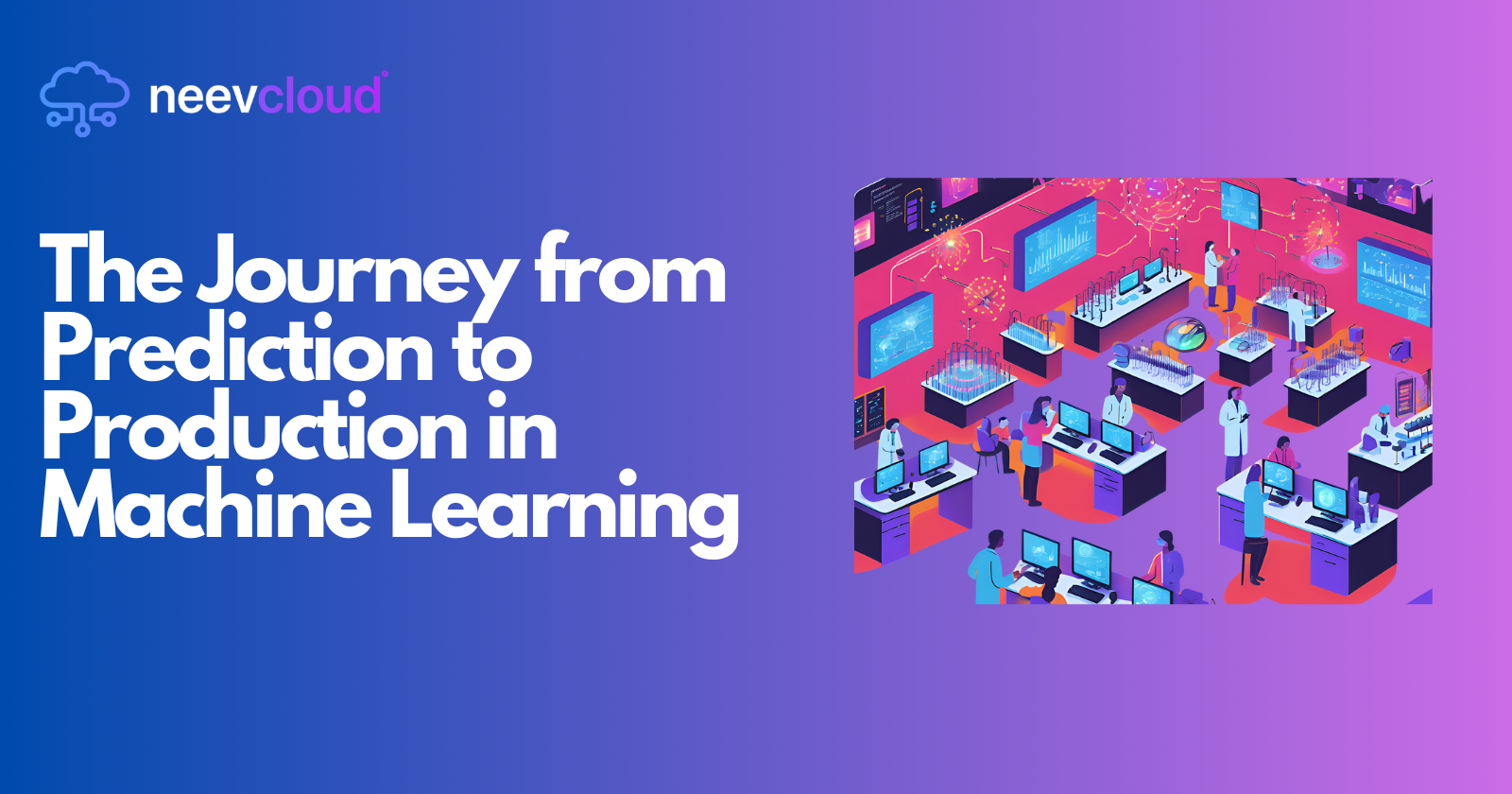The Journey from Prediction to Production in Machine Learning
 Tanvi Ausare
Tanvi Ausare
The rise of Artificial Intelligence (AI) and Machine Learning (ML) has revolutionized numerous industries. From finance to healthcare, retail to autonomous systems, organizations are increasingly relying on AI-ML models to gain insights, enhance decision-making, and improve efficiency. However, one of the most significant challenges lies in moving from the research phase—where models are trained and validated—to deploying these models in production, where they provide real-time predictions at scale.
In this blog, we’ll dive into how businesses can streamline this critical transition using AI Cloud services, with a focus on moving from "Prediction to Production" in Machine Learning environments. The goal is to leverage Cloud Machine Learning platforms to simplify, optimize, and automate these processes.
Key Concepts
Before we delve deeper into the methodology, let’s first clarify a few key concepts relevant to the topic:
Prediction: The phase where an ML model is used to forecast outcomes based on input data.
Production: The operational stage where ML models provide predictions in real-world applications at scale.
AI Cloud: Cloud platforms designed to develop, train, and deploy AI and ML models, while managing resources and scaling as needed.
Challenges in Moving from Prediction to Production
Deploying ML models from prediction to production presents several challenges. These obstacles are compounded as the scale of the application increases:
Model Optimization: Models developed in research environments often need to be optimized for production environments to ensure faster inference times and lower computational costs.
Infrastructure Complexity: Managing infrastructure for AI-ML applications involves dealing with compute, storage, networking, and hardware acceleration like GPUs.
Version Control: Keeping track of different model versions and ensuring the right one is deployed in production.
Monitoring & Scaling: Once in production, ML models must be monitored for performance degradation, accuracy, and drift, while the infrastructure needs to scale dynamically.
How Cloud Machine Learning Platforms Simplify the Journey
Cloud ML platforms such as those provided by NeevCloud offer an array of services to streamline the ML lifecycle. Here’s a breakdown of how these platforms simplify the transition:
1. Infrastructure Abstraction
AI Cloud platforms provide an abstraction layer over the complex underlying infrastructure.
Developers don’t need to manually provision or manage hardware such as GPUs, CPUs, or storage.
Resources can be dynamically scaled to meet demand, ensuring that models can handle high workloads without over-provisioning.
2. End-to-End ML Workflow
Cloud ML platforms integrate various stages of the ML lifecycle: from data ingestion to model training, and from evaluation to deployment.
Tools like MLOps automate the entire process, including data pipelines, model tracking, and production deployment.
3. AutoML for Rapid Prototyping
Automated Machine Learning (AutoML) tools available in cloud environments significantly reduce the time required to train and optimize models.
AutoML allows data scientists to experiment with different algorithms, automatically fine-tune hyperparameters, and rapidly iterate over models without manual intervention.
4. Optimized GPU Cloud for Machine Learning
Cloud platforms like NVIDIA GPU Cloud (NGC), which NeevCloud also provides, deliver optimized environments for ML model training and inference.
Preconfigured containers with popular ML frameworks like TensorFlow, PyTorch, and MXNet allow you to start training models right out of the box.
5. Continuous Integration & Continuous Deployment (CI/CD)
Cloud platforms provide CI/CD pipelines specifically designed for AI-ML projects.
You can automate model deployment to production, making sure that updates to the model can be seamlessly integrated with minimal downtime.
Step-by-Step Guide: From Prediction to Production Using AI Cloud
Here’s a practical step-by-step guide on how to move from prediction to production in a cloud-based ML environment using AI Cloud services:
1. Data Ingestion and Preparation
Utilize cloud-based data storage solutions such as NeevCloud's distributed data lake.
Perform data cleaning, transformation, and labeling in the cloud to prepare data for ML model training.
2. Model Development and Training
Use cloud GPU resources to accelerate model training, leveraging popular frameworks such as TensorFlow or PyTorch.
Implement hyperparameter tuning and use AutoML features to iterate quickly on model design.
3. Model Validation and Testing
Test your model using cloud-based validation tools.
Evaluate performance metrics such as accuracy, precision, and recall on various datasets stored in the cloud.
4. Model Optimization for Production
Optimize the model for inference using AI accelerators like TPUs or GPUs.
Use cloud services to shrink the model’s size without sacrificing accuracy (e.g., using model pruning or quantization).
5. Containerization and Model Deployment
Containerize your model using Docker and deploy it to the cloud using managed services like NeevCloud’s Kubernetes.
Deploy RESTful APIs or integrate the model with existing applications.
6. Monitoring and Maintenance
Monitor the performance of the deployed model using cloud monitoring tools.
Set up automated alerts for model drift or performance degradation.
Utilize cloud CI/CD pipelines to retrain and redeploy models seamlessly as new data becomes available.
Benefits of Using Cloud Machine Learning Platforms
Cloud ML platforms offer numerous benefits that make the prediction-to-production process smoother and more efficient. Here are a few key advantages:
1. Scalability
- Cloud-based ML platforms allow models to scale effortlessly based on demand. Resources can be scaled horizontally or vertically without manual intervention.
2. Cost Efficiency
- With pay-as-you-go pricing models, organizations can optimize costs. Companies don’t have to invest in expensive hardware or over-provision resources.
3. Collaborative Environment
- Data scientists, ML engineers, and DevOps teams can collaborate seamlessly in the cloud. Using tools like NeevCloud’s collaborative notebooks allows teams to work on the same project without worrying about local setup.
4. Security
- Cloud platforms offer robust security features such as encryption at rest and in transit, role-based access control, and multi-factor authentication to ensure that data and models are secure.
5. Faster Time-to-Market
- The integration of all ML lifecycle components (data preparation, model training, validation, and deployment) within a unified cloud environment significantly reduces the time it takes to bring models to production.
AI-ML Use Cases: From Prediction to Production
Real-world use cases of moving from prediction to production demonstrate the impact of using cloud-based solutions:
1. Healthcare
- AI models are used to predict patient outcomes, and cloud infrastructure ensures that these predictions can be scaled across healthcare networks globally.
2. Retail
- In retail, machine learning models are trained to forecast demand and optimize supply chains. Cloud ML platforms enable these models to operate in real-time, ensuring immediate responses to changing market conditions.
3. Financial Services
- Fraud detection systems use AI models that continuously evolve as new transaction data is ingested. Cloud platforms allow these models to be retrained and deployed with minimal downtime, improving security in real-time.
Best Practices for Moving to Production
Transitioning from a prediction stage to production in a cloud ML environment can be optimized with the following best practices:
Data Management: Ensure that your data pipeline is robust, scalable, and secure. Use cloud-based data storage solutions to handle large datasets efficiently.
Model Performance Monitoring: Continuously monitor the performance of models in production. Use tools that can alert your team to anomalies or drift in model performance.
Cost Management: Keep an eye on resource utilization to avoid over-provisioning. Use cloud-native tools for autoscaling and optimization.
Version Control: Implement robust version control for models and data. This will help ensure that production environments can be reverted if a new model version doesn’t perform as expected.
Conclusion
Moving from prediction to production in machine learning is a complex journey that can be made simpler by leveraging AI Cloud services. The ability to abstract infrastructure complexities, scale resources, and automate key stages of the ML lifecycle means businesses can bring their ML models to production faster, more efficiently, and with greater reliability.
Platforms like NeevCloud offer all the essential tools and services needed to make this transition seamless. Whether you're dealing with large-scale data, complex model architectures, or real-time applications, cloud machine learning environments provide a robust solution for moving your models from research to production.
By following the steps and best practices outlined in this blog, companies can unlock the full potential of AI and machine learning in real-world applications.
Subscribe to my newsletter
Read articles from Tanvi Ausare directly inside your inbox. Subscribe to the newsletter, and don't miss out.
Written by
